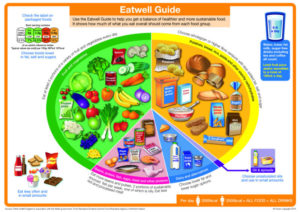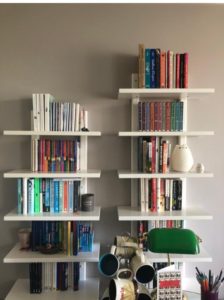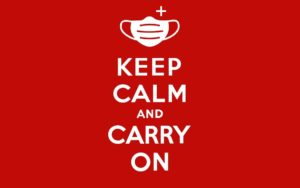Self-isolation, social distancing and wellbeing
I’ve recently written a couple of posts about the COVID-19 pandemic. Unfortunately, the situation has dramatically changed since then; the number of cases and coronavirus-related deaths has sharply increased around the world. As I am writing this post, the death toll has reached 422 in the UK alone, whereas the total number of confirmed cases is now 8,077 across the country. On a global level, so far we have had 18,251 fatalities and 407,678 confirmed cases. As many countries are now in lockdown (including the UK as of this week), the terms ‘self-isolation’ and ‘social distancing’ have entered our daily vocabulary. In these challenging times, we should not forget our mental wellbeing.

A year and a half ago, I wrote about the 10 key areas (or pillars) of our daily life; I described how small changes/improvements in each of these 10 key areas (or pillars) could maximize one’s wellbeing and contribute to a happier and healthier life. In line with those posts, I would now like to consider these recommendations in the context of self-isolation and social distancing.
On a personal level, I have been working from home for the last few days, which means I no longer spend 3 hours of my day commuting. At the game time, I have stopped socializing, attending cultural events (i.e. theatre, cinema, concerts etc), going to the gym (or to yoga classes), and going for a coffee to my local cafes in Ealing and Chiswick. Let me be clear: I am not complaining. The point I would like to make is that I now have a lot of free time, which allows me to re-focus my attention to some of the 10 key areas of my daily life that – I hate to admit – I had been neglecting.
-
Sleep well
Thanks to self-isolation, social distancing and the subsequent changes to my routine, I now have more time to rest and sleep, so I now make sure I sleep for at least 8 hours a day. I would imagine that most people are in the same situation. Our lives are perhaps a bit less busy than usual, which provides a great opportunity to rest and sleep.
But, why is sleep so important?
The association between sleep and mental wellbeing/health is bidirectional. Not only mental illnesses (i.e. anxiety and depression) can affect and disrupt our sleep, but also sleep deprivation/difficulties can compromise our mental wellbeing/health.
Although, as a Psychiatrist, I am well aware that sleeping well is essential for one’s mental wellbeing/health, there is little I can do to help people sleep better (at least in terms of prescribing medication). Sleeping tablets (or hypnotic medications) are notorious for often being ineffective (especially in the longer term) as well as for their side effects, and this is why many doctors are often reluctant to prescribe them.
The good news is that there are things you can do to improve your sleep. These are usually referred to as ‘sleep hygiene’, and focus on the following areas:
- Sleep routine and consistency
- Relaxation
- Environment
- Food and drinks
- Exercise
- Worrying
- Sunlight
For further detail on sleep hygiene and how you can improve your sleep, read my post ‘Counting sheep: 7 tips for better sleep’.
2. Eat healthily
In 1997, long before the COVID-19 pandemic, the World Health Organization drew our attention to obesity, which was recognized as a global epidemic. Nowadays, we all know that our diet, nutrition and eating habits can affect our physical health. For example, a diet rich in antioxidants may protect against many illnesses, including cancer.
Fewer of us, however, know that our diet, nutrition and eating habits can affect our mental health too. At the end of the day, the distinction between mind (mental health) and body (physical health) is a rather philosophical one, since the brain is part of the human body the same way that the heart or the gut are.
Nutrition is an exciting field where new information constantly comes to light; however, this has resulted in a plethora of often confusing and contradictory information coming from various sources: scientific research, as well as online articles, blogs, social media and books.
Simple nutritional recommendations
As a doctor myself, nutrition is something that I am really passionate about, since I believe it plays such an important role in both our physical and mental health, as well as our overall wellbeing. To avoid confusion, I would like to make some simple nutritional recommendations which will hopefully contribute to better physical and mental health:
- Have three regular main meals: breakfast, lunch and dinner.
- Have healthy snacks between the main meals.
- Eat mindfully.
- Eat in moderation, not too much.
- Follow a varied but balanced diet of protein, carbohydrate and fat (use the UK Eatwell Guide or other official recommendations as a guide).
- Eat your 5 (fruit and vegetables) a day.
- Drink plenty of water, but drink alcohol in moderation, not in excess.

Self-isolation and healthy eating
During these challenging times, however, these recommendations may not be as easy to follow. On the one hand, in line with the self-isolation and social distancing recommendations, we should avoid going out (including to super-markets and grocery stores) as much as usual. On the other hand, in the UK at least, access to fresh produce has recently been rather problematic. Due to panic-buying and stock-piling there has been a mismatch between supply and demand. In fact, I have been to super-markets completely devoid of fresh produce (not only fresh meat, but also fruit and vegetables). This situation may encourage us to make less healthy choices (i.e. consume more carbs and less fruit and vegetables). Personally, I have been struggling to keep a balanced diet of protein, carbohydrate and fat, and to eat my 5 (fruit and vegetables) a day.
3. Exercise regularly
Self-isolation and social distancing have also reduced the opportunities for physical movement and exercise.
We all know that exercise and physical activity are beneficial to our physical health. For example, exercise helps improve our physical health by reducing the risk of cardiovascular disease (such as coronary heart disease and stroke), the risk for diabetes (type 2) and metabolic syndrome, and risk of some cancers (including colon and breast cancers). It also helps control our weight, strengthen our bones and muscles (therefore reducing the risk of osteoarthritis and hip fractures), and overall increase our chances of living longer.
But exercise and physical activity can be beneficial to our mental health too, including our mood and cognition. Research has shown that exercise lowers the risk of dementia and depression, by releasing endorphins. Exercise can also foster our sense of self-worth and increase our self-confidence not only by making us feel better about our appearance, but also by helping us gain a sense of achievement and mastery. For these reasons, I often prescribe exercise and physical activity to my patients.
On a personal level, I try to walk 10,000 steps each day, but I also go to a yoga class once or twice weekly, and to the gym for weight lifting also twice a week. Out of all these activities, yoga is my favorite, as it is more than just physical exercise. Having a meditative and spiritual core, as well as combining physical exercise with an awareness of breath, yoga also helps me relax and unwind.
Self-isolation and exercise
Under the current circumstances, the opportunities for exercise and physically activity have reduced. However, there is no reason to neglect this key area of our daily life and wellbeing.
First, we can still exercise at our home. Of course, it is not the same as going to the gym. However, although we may not have access to a personal trainer or gym classes, let alone weights and other equipment, there are still plenty of exercises we can do on our own. YouTube is a wonderful resource; I personally follow Olympic diver Tom Daley who has created a number of videos with simple workouts that can be easily done at home.
Second, there are many online yoga classes. The ‘Down Dog’ app not only allows one to practice yoga at home, but they now offer the premium version for free. The YouTube channel ‘Yoga with Adriene‘ is another wonderful way to practice yoga, as well as meditation, in the comfort of your home.
Third, at least in the UK, we are still allowed to go out to exercise, despite the strict measures currently in place. Lucky us, the weather is on our side (at least this week). So, we can still go out for a jog or even for a long walk; so, I have no excuse not to walk (or run) my 10,000 steps a day.
4. Relate (despite self-isolation and social distancing)
Relationships are an important part of most people’s life; research has shown that they are essential to our wellbeing. I do not refer only to romantic relationships; our social network includes friends, family, colleagues, neighbors, teammates and so on.
In the current climate, however, the way we relate and interact with others has to change and our relationships will subsequently be affected. Self-isolation and social distancing have reduced the opportunities to be with others and socialize. However, we can (and should) still maintain our relationships, especially the most important ones. On the one hand, we have the perfect opportunity to spend some quality time with those we live with: we can have a meal together, talk, play games, or engage in other activities. On the other hand, thanks to technology, we can still call (or video-call even) our friends and family who live elsewhere.
A therapeutic relationship
At this point, I would like to briefly discuss a special type of relationship, the relationship with a therapist. Let me start here by saying that I strongly believe that psychological therapy is not just for those who have a mental illness. It can help anyone who has some sort of psychological, emotional or interpersonal difficulties (i.e. low self-esteem, anger or relationship problems), as long as they’re open to this therapeutic approach.
But, what exactly is this therapeutic approach? Or, therapeutic approaches rather, since there’s a large number of psychological therapies; these therapies differ both in their theory and the therapeutic approach used. Although they’re collectively known as ‘talking therapies’, some psychological therapies encourage ‘doing’ and learning practical skills, and not just ‘talking’; this is particularly true for CBT, mindfulness-based therapies, and art therapy.
Despite their different therapeutic approaches, different psychological therapies have a very important element in common: the relationship with the therapist (often called therapeutic relationship or alliance). Research shows that this plays a very important role in the outcome of therapy (whether it is successful or not) no matter what therapeutic approach has been used.
Another benefit (again irrespective of the type of psychotherapy) is that they encourage us to pay close attention to our internal world (feelings and thoughts) and this alone can often be therapeutic. Psychotherapies provide a space where this internal world can be acknowledged, validated, understood and explored, and I strongly believe that this is where one of their greatest benefits lies.
Self-isolation and therapy
During these challenging times, many therapists continue providing psychotherapy sessions, albeit remotely (thanks once again to technology). As mentioned earlier, I believe that psychological therapy can be helpful to many of us. In times like this, however, when a lot of people may be feeling more anxious than usual, the role of psychological therapy cannot be emphasized enough.
If you live in the UK and would like some psychological support, these two wonderful resources provide psychotherapies free of charge:
The Improving Access to Psychological Therapies (IAPT) program was introduced in 2008 to provide psychological therapies (mostly CBT) for common mental health conditions (such as anxiety and depression) in primary care settings. More recently, it has expanded to also provide psychological therapies for long-term physical health conditions and medically unexplained symptoms. IAPT accepts referrals from general practitioners, as well as self-referrals.
MIND is a mental health charity with branches all over the country. Psychotherapy is one of the many services it provides.
5. Read books
I recently wrote about the Japanese concept of tsundoku, which refers to the habit of buying books, and storing them (piling them up) without actually reading them.
For many of us, self-isolation and social distancing have provided a great opportunity to read all these books that may have been sitting on our bookshelves for quite some time.

I personally read for a multitude of reasons, such as enjoyment, information/education, or simply to pass my time (or to fight boredom).
Bibliotherapy
But, reading can be much more than that: it can be therapeutic. It can be an effective way to improve one’s mental wellbeing. In fact, this is exactly what ‘bibliotherapy’ refers to: the therapeutic use of reading and storytelling.
I have previously written about self-help books as a resource that can help with psychological or emotional difficulties. Often using therapeutic techniques used in therapy, self-help books can be very useful as a first step, whilst waiting for therapy, or as an adjunct to therapy. Although they’re lacking the therapeutic relationship with the therapist, they are excellent in that they provide psycho-education and support for self-care. Like psychotherapy, they encourage us to pay close attention to our internal world; they can also empower us to take steps to improve our mental health and wellbeing. In fact, there is a huge evidence base around the value of reading to support health and wellbeing.
Having said that, I would like to make it clear that the beneficial effects of reading books are not limited to self-help books. In the article ‘Short- and Long-Term Effects of a Novel on Connectivity in the Brain’, published in the Brain Connectivity journal, the authors (Berns et al.) describe an experimental study to find out whether reading novels can cause changes in brain function and structure. To determine that, they used functional magnetic resonance imaging (fMRI) to track changes in the participants’ brain activity. Their findings support their hypothesis that reading novels can cause longer-term changes in the connectivity of the brain. Further research studies are nonetheless required to inform on the generalizability and the clinical implications of their findings.
6. Meditate and be mindful
Alongside having more time to sleep, exercise and read books, I now have more time to also meditate and practice mindfulness. I have previously written about the importance of mediation and mindfulness for our wellbeing; yet, I have to admit that I have personally rather neglected this key area.
What is mindfulness?
Derived from Buddhist traditions, mindfulness is a psychological process of bringing our attention to experiences occurring in the present moment. It has gained increasing popularity in the West since 1970, and has been extensively studied as a therapeutic intervention in the management of mental health difficulties. At the same time, it has often been heralded as a way to improve our mental wellbeing (even in the absence of mental disorder or mental health difficulties).
To better define mindfulness, I’m going to quote Dr Jane Hutton, Consultant Clinical Psychologist in Psychological Medicine at King’s College Hospital.
“Mindfulness can be defined as paying attention in a particular way in the present moment. It can be cultivated in every moment of our everyday lives – for example, walking down the street looking around us rather than looking down at our phones. It can also be cultivated through structured practices, for example, meditations on the breath and on the body. Our intention in practicing mindfulness is to cultivate an enhanced awareness of what’s going on in the present moment, and that’s both externally in the world around us but also internally: our thoughts, our emotions, our bodily sensations and how they can all affect one another. It is about cultivating awareness of things as they are right now, but it’s also making deliberate, conscious choices that can help us to change things where that’s possible and where that might be helpful”.
Quite often we use the word ‘meditation’ alongside or even interchangeably with ‘mindfulness’. So, is meditation the same as mindfulness? Not quite. Mindfulness is a skill that can be practiced through meditation. It can also be practiced through other activities, such as mindful moving, walking or running, mindful coloring and drawing (a large number of mindful coloring books have recently become available, and they’re not just for kids), body scan, breathing exercises, and yoga.
So, how can mindfulness help?
As already mentioned, mindfulness strategies can be helpful to most of us and not only to those affected by mental (or even physical) illness. Mindfulness can help us become less reactive to stress, build resilience, cope better with health problems (including long-term physical illnesses) and reduce psychological distress. It can be practiced independently (via self-help books, online videos, and apps, such as Headspace), but there are also many courses and structured programs available.
Mindfulness can help us:
- become more self-aware
- feel calmer and less stressed
- feel more able to choose how to respond to our thoughts and feelings
- cope with difficult or unhelpful thoughts
- be kinder towards ourselves
In the current climate, I believe that practicing mindfulness and meditating can help us cope not only with the uncertainty and the anxiety associated with the COVID-19 pandemic, but also with the potential loneliness due to self-isolation and social distancing.

7. Be positive and grateful
The proverb ‘every cloud has a silver lining’ is a metaphor for optimism meaning that a negative occurrence may have a positive aspect to it. I think it perfectly applies to the current situation. To avoid any misunderstanding, let me be entirely clear: I am specifically referring to self-isolation and social distancing. As I’m trying to demonstrate with this post, self-isolation can provide a perfect opportunity to re-examine our lives and re-focus our attention on some of the 10 key areas of our daily life that we may have been neglecting. By doing so, we can help improve our mental wellbeing during these challenging times.
On the one hand, we should stay at home and stay safe. On the other hand, we should also stay positive. We should try to see the glass as half-full rather than half-empty. Perhaps this is easier said than done, but positive thinking is indeed a skill that can be practiced, learned and become an effective stress management strategy.

How can positive psychology help?
One simple yet effective strategy is to reflect on our every day, identify and write down three positive things about that day, or three things we are grateful about. This can help us create a more positive mindset; it can also help us focus on the positive aspects of our everyday lives, rather than dwell on our shortcomings.
Even better, positive thinking and optimism have been associated with both mental wellbeing and physical health benefits, such as:
- Better coping skills during hardships and times of stress
- Lower rates of depression
- Lower levels of distress
- Better mental and physical wellbeing
- Greater resistance to the common cold
- Better cardiovascular health and reduced risk of death from cardiovascular disease
- Increased life span
Gratitude
I believe that gratitude goes hand in hand with positive thinking. Quite often we focus on what could be different or better, and this can easily trigger or perpetuate negative emotions, including stress, sadness, or even anger. Feeling grateful, even in the face of adversity, is a way to break this cycle and help create a more positive mindset.
8. Have a routine
The COVID-19 pandemic has undoubtedly interrupted our lives and disrupted our routines. Many of us no longer go to work or school, or take part in our routine activities.
I have previously written about the importance of having routines and a structure to one’s days, weeks, and life. Routines and structure are important because they provide a sense of security and familiarity, as well as order, direction and meaning. They also help provide a sense of achievement (purpose) as well as enjoyment (pleasure). All these are essential ingredients for a happy and balanced life.
So, we must try to build a new routine during this time of self-isolation and social distancing.
In keeping with the structure of the 10 key areas (or pillars) I’m discussing here (pun intended), for most of us, a typical day of self-isolation should include:
- 7-8 hours of sleep
- 3 meals
- Exercise
- Purposeful activities (i.e. occupational and/or educational activities)
- Pleasurable activities
In addition to the above, reading books, practicing mindfulness/meditation, as well as positive thinking and gratitude, can easily be incorporated into our everyday lives for optimal wellbeing.
9. Find purpose
Whether we’re still going to work (or school), or we’re now working/studying from home, these occupational and/or educational activities are essential for our wellbeing. Such activities give purpose to our lives, and significantly add to the routine I’ve previously mentioned. Purposeful activities can also foster our sense of self-worth and increase our self-esteem by helping us gain a sense of achievement and mastery.
Unfortunately, purposeful activities are not always pleasurable. Most of us work or study because we have to, rather than want to do it. I have to admit that I do not always find my work pleasurable; however, I’d much rather view it as purposeful, as opposed to something that simply has to be done. In other words, just by choosing a different set of words, I reframe a substantial part of my daily life, and I therefore view it in a much more positive way.
Of course, it would be even better if we manage to derive pleasure from such purposeful activities. For instance, education is often an activity that is both purposeful and pleasurable, especially if we have chosen the subject of our studies (i.e. when studying for a degree, as opposed to going to school).
Beyond work and studies
The same applies to several other activities that could be also classified as purposeful, such as learning a foreign language or a musical instrument. For some of us (especially the young), these can be things we simply have to do; for others (usually the grown-ups), they are hobbies, which are mostly regarded as pleasurable activities (as well as purposeful).
Under the current circumstances, these activities may give a significant purpose to our lives, provide a sense of achievement and add to the disrupted routine, especially for those who are no longer working.
10. Find pleasure
“A hobby a day keeps the shrink (me) away!” says Geir Berthelsen, the founder of the World Institute of Slowness. He adds that hobbies help us appreciate life here and now.
I couldn’t agree more. Pleasurable activities (i.e. hobbies) add to the routine and structure in our life. As we’ve seen, they can often be purposeful, as well as pleasurable. But most of all, as the name suggests, they provide enjoyment and pleasure.
To paraphrase Marie Kondo, we need activities that spark joy!
Here are a few activities that most of us would consider pleasurable, and that we can easily incorporate into our daily lives, despite the self-isolation and the social distancing:
- Spending time with pets
- Relaxing
- Cooking and/or baking
- Exercising
- Creating art
- Watching a film (at home)
- Listening to music
- Reading
- Learning (i.e. a foreign language or a musical instrument)
- Creative writing
These activities are not only pleasurable, but they can also be therapeutic. Research has shown that they can be beneficial for our mental health and wellbeing, and there are forms of therapy utilising some of these activities (i.e. art therapy, music therapy, bibliotherapy etc).
The power of music
Let’s take music as an example:
Many research studies provide evidence in support for the beneficial role of music (classical, as well as some other types of music) on both physical and psychological symptoms. For example, a systematic review indicated that listening to music might have a beneficial effect on physiological parameters (such as blood pressure, heart rate, and respiratory rate), anxiety, and pain in people with coronary heart disease. Another systematic review concluded that music interventions might have beneficial effects on anxiety, pain, fatigue, and quality of life in patients with cancer.
Music therapy and the Mozart effect
We can often see the health benefits of listening to music in the context of music therapy. This is an umbrella term for evidence-based interventions that use music in a therapeutic context. There are two types of music therapy: receptive (listening to music), and active or expressive music therapy (playing or creating music). Music therapy has been evaluated in a number of different physical and mental conditions, including dementia, and the results are positive.
The ‘Mozart Effect’ refers to the positive effect that classical music has on cognitive skills. Researchers found that listening to the Sonata for Two Pianos in D major, K. 448 by Mozart improved spatial reasoning skills (part of the widely used Stanford-Binet IQ test). It is rather unclear whether this effect is specific to this particular piece of music or applies to classical music in general. Music composed by Yanni (‘Acroyali/Standing In Motion’) was also found to have a similar effect. It may be that the positive effect on cognitive abilities is mediated by musical patterns shared by Mozart’s and Yanni’s compositions.
Online performances
Unfortunately, many performance art (i.e. theatre, opera, ballet) productions and events have been postponed or cancelled due to self-isolation and social distancing. On a more positive note, however, the National Theatre and the Royal Opera House will be streaming past performances on YouTube.
National Theatre
‘One Man, Two Guvnors’ will be available from 2 to 9 April 2020. It will be followed by ‘Jane Eyre’ (from 9 to 16 April 2020), ‘Treasure Island’ (from 16 to 23 April 2020) and ‘Twelfth Night’ (from 23 to 30 April 2020).
Royal Opera House
The following ROH productions will be available for a limited time on YouTube:
‘Peter and the Wolf’, The Royal Ballet (from 27 March until 26 April 2020)
‘Acis and Galatea’, The Royal Opera (from 3 April 2020)
‘Così fan tutte’, The Royal Opera (from 10 April 2020)
‘The Metamorphosis’, The Royal Ballet (from 17 April 2020)
‘Gloriana’, The Royal Opera (from 24 April 2020)
‘The Winter’s Tale’, The Royal Ballet (from 1 May 2020)
Further reading
For more recommendations for each of the 10 key areas of our daily life, check out my posts:
10 tips for better mental health & wellbeing (part 1)
10 tips for better mental health & wellbeing (part 2)
Stay at home, stay positive and stay safe!
Alex
(the London-based Traveling Psychiatrist)
4 Comments
Pingback:
Pingback:
Pingback:
Pingback: